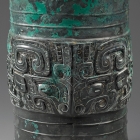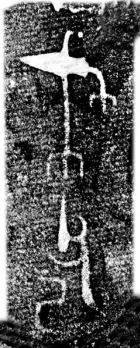J.J. Lally & Co., Oriental Art / New York City, New York
MenuPast Exhibition
Chinese Archaic Bronzes:
The Collection of Daniel Shapiro
March 14 - April 5, 2014
13.
ZUN 尊
Early Western Zhou Period, 11th Century B.C.
of cylindrical form with trumpet mouth and splayed foot, decorated with a raised panel at the midsection cast in varied relief with two large taotie with ‘C’-scroll horns above protruding oval eyes and pointed ears on either side of a ridged nose with curled nostrils descending from a shield-shaped forehead to center an open jaw defined by hooked fangs, all flanked by pairs of kui dragons with slender spurred quills for bodies aligned one above the other with jaws open, the taotie and dragons with plain smooth surfaces sparsely detailed with intaglio scroll motifs, reserved on a very finely cast ground of leiwen spiral scrolls and framed by pairs of raised ‘bowstring’ lines above and below, the surface with smooth silvery gray patina showing bright green malachite encrustation on the upper half of the vessel, with an inscription of three pictograms cast on the interior base.
Height 10 1⁄8 inches (25.7 cm)
The pictograms may be read as: 戈父己 (ge fu ji)
Provenance
J. J. Lally & Co., New York, 2000
A zun of very similar form and design in the Burrell Collection, Glasgow, cast with twin taotie flanked by very similar pairs of kui dragons, is illustrated by Rawson, Western Zhou Ritual Bronzes from the Arthur M. Sackler Collections, Vol. IIB, Cambridge, 1990, p. 550, Fig. 79.2, shown by the author for comparison with a zun in the Sackler Collection of very similar form with a different arrangement of kui dragons around the taotie, illustrated op. cit., p. 549, no. 79, attributed by Rawson to late Shang or early Western Zhou. Compare also the zun of very similar form cast with twin taotie and kui dragons in a similar pattern, discovered in a Western Zhou tomb at Baicaobo in Lingtai county, Gansu province, illustrated in Kaogu Xuebao, 1977, No. 2, pl. 5:4, with brief description on pp. 106–107.
西周早期 戈父己尊 高 25.7 厘米


